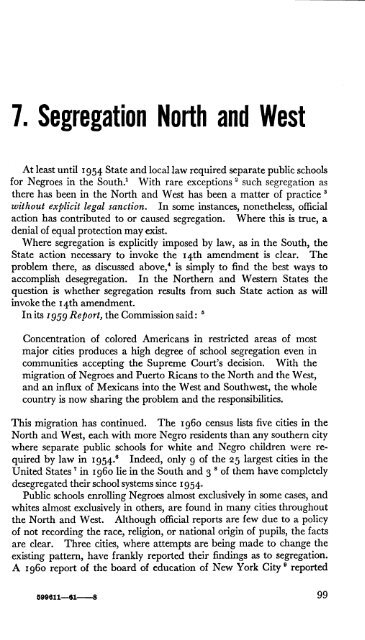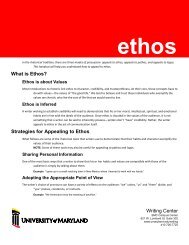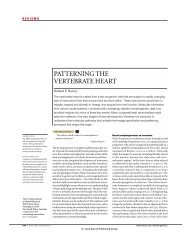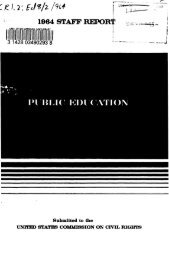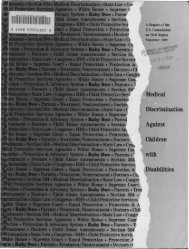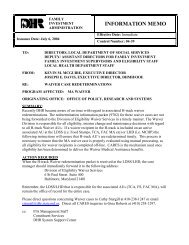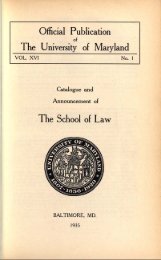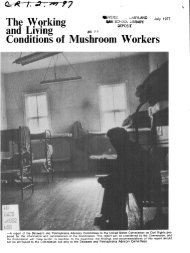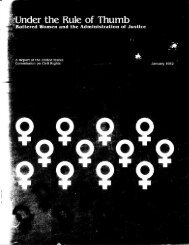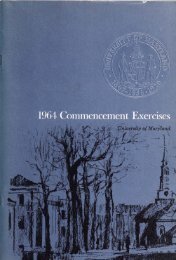1961 US Commission on Civil Rights Report Book 2 - University of ...
1961 US Commission on Civil Rights Report Book 2 - University of ...
1961 US Commission on Civil Rights Report Book 2 - University of ...
You also want an ePaper? Increase the reach of your titles
YUMPU automatically turns print PDFs into web optimized ePapers that Google loves.
7. Segregati<strong>on</strong> North and West<br />
At least until 1954 State and local law required separate public schools<br />
for Negroes in the South. 1 With rare excepti<strong>on</strong>s 2 such segregati<strong>on</strong> as<br />
there has been in the North and West has been a matter <strong>of</strong> practice 3<br />
without explicit legal sancti<strong>on</strong>. In some instances, n<strong>on</strong>etheless, <strong>of</strong>ficial<br />
acti<strong>on</strong> has c<strong>on</strong>tributed to or caused segregati<strong>on</strong>. Where this is true, a<br />
denial <strong>of</strong> equal protecti<strong>on</strong> may exist.<br />
Where segregati<strong>on</strong> is explicitly imposed by law, as in the South, the<br />
State acti<strong>on</strong> necessary to invoke the I4th amendment is clear. The<br />
problem there, as discussed above, 4 is simply to find the best ways to<br />
accomplish desegregati<strong>on</strong>. In the Northern and Western States the<br />
questi<strong>on</strong> is whether segregati<strong>on</strong> results from such State acti<strong>on</strong> as will<br />
invoke the I4th amendment.<br />
In its 1959 <strong>Report</strong>, the <str<strong>on</strong>g>Commissi<strong>on</strong></str<strong>on</strong>g> said: 6<br />
C<strong>on</strong>centrati<strong>on</strong> <strong>of</strong> colored Americans in restricted areas <strong>of</strong> most<br />
major cities produces a high degree <strong>of</strong> school segregati<strong>on</strong> even in<br />
communities accepting the Supreme Court's decisi<strong>on</strong>. With the<br />
migrati<strong>on</strong> <strong>of</strong> Negroes and Puerto Ricans to the North and the West,<br />
and an influx <strong>of</strong> Mexicans into the West and Southwest, the whole<br />
country is now sharing the problem and the resp<strong>on</strong>sibilities.<br />
This migrati<strong>on</strong> has c<strong>on</strong>tinued. The 1960 census lists five cities in the<br />
North and West, each with more Negro residents than any southern city<br />
where separate public schools for white and Negro children were required<br />
by law in I954- 6 Indeed, <strong>on</strong>ly 9 <strong>of</strong> the 25 largest cities in the<br />
United States 7 in 1960 lie in the South and 3 8 <strong>of</strong> them have completely<br />
desegregated their school systems since 1954.<br />
Public schools enrolling Negroes almost exclusively in some cases, and<br />
whites almost exclusively in others, are found in many cities throughout<br />
the North and West. Although <strong>of</strong>ficial reports are few due to a policy<br />
<strong>of</strong> not recording the race, religi<strong>on</strong>, or nati<strong>on</strong>al origin <strong>of</strong> pupils, the facts<br />
are clear. Three cities, where attempts are being made to change the<br />
existing pattern, have frankly reported their findings as to segregati<strong>on</strong>.<br />
A 1960 report <strong>of</strong> the board <strong>of</strong> educati<strong>on</strong> <strong>of</strong> New York City 9 reported<br />
699611—«1 8 99


